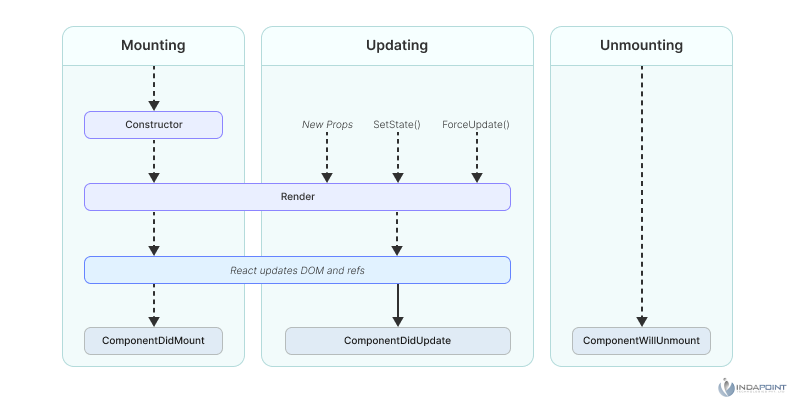React.js Performance Optimization: How to Make Your Apps Fly
October 9, 2023

This comprehensive guide to performance optimization for React.js apps aims to help users experience faster, responsive, and more engaging web experiences. It covers the rendering process, virtual DOM, component lifecycle, and performance tools like React DevTools and Chrome DevTools. Techniques include lazy loading and code splitting, memoization and PureComponent, state and props optimization, server-side rendering (SSR) and serverless architecture, and third-party library optimization. Real-world case studies demonstrate the impact of these optimization techniques. The guide also emphasizes the importance of choosing the right technology stack, comparing React.js with other options like Angular and Vue.js, and maintaining ongoing performance monitoring. IndaPoint Technologies Pvt. Ltd offers expert advice, tailored solutions, proven results, and continuous support to help businesses optimize their React.js apps and achieve success in the digital landscape.
React.js Performance Optimization : How to Make Your Apps Fly
Is the performance of your React.js application a tad sluggish? Users encountering irritating load times and unresponsive interfaces? If so, it may be time to optimize the performance of your React.js application. In today’s fast-paced digital landscape, where user experience can make or destroy your business, it is crucial to ensure that your React.js application runs smoothly. In this comprehensive guide, we’ll take you through the key strategies and techniques for making your React.js applications fly, thereby delighting your users and retaining their interest.
Understanding the Performance of React.js
Let’s take a moment to comprehend what affects the performance of React.js applications before diving into optimization techniques.
React.js employs a virtual DOM to efficiently update the actual DOM during the rendering process. Understanding the operation of this procedure is essential for identifying performance obstacles.
- Virtual DOM : Virtual DOM is an integral component of React’s performance. It is essential to comprehend how it functions and how to utilize it.
- Component Lifecycle : Optimizing React.js applications requires knowledge of when and how components are mounted, updated, and unmounted.

React.js Performance Tools To optimize your React.js application, you require the proper tools.
Here are some indispensable instruments for performance analysis :
- Tools for Profiling and Debugging : React DevTools and Chrome DevTools offer insights into component rendering and state modifications, among other things. They aid in identifying performance issues.
- Measuring and Comparison : Before you can enhance performance, you must measure it. Tools such as Lighthouse and WebPageTest can help you compare the efficacy of your application to industry standards.
React.js Performance Enhancement Methods
Now, let’s examine the techniques that will allow you to supercharge your React.js application :
- Sluggish Loading and Code Splitting : Employ sluggish loading and code splitting to load only the necessary components when they are required, thereby reducing initial load times.Utilize Memo and PureComponent to prevent superfluous re-renders and increase rendering efficiency.

- State and Equipment Optimisation : Effectively manage state and variables to avoid unnecessary updates that can slow down your application.
- Server-side Rendering (SSR) and Serverless Architecture : For quicker initial page loads, consider implementing SSR. Additionally, serverless architecture can help optimize server-side operations.
- Third-party Library Optimization : Evaluate and optimize external dependencies to reduce their impact on the efficacy of your application.
Instance Studies
To illustrate the impact of these optimization techniques, let’s examine a few case studies from the real world. In each instance, businesses saw significant performance enhancements in their React.js applications.
Selecting the Appropriate Technology Stack
React.js is a potent front-end technology, but it’s important to compare it to alternatives such as Angular and Vue. Each has advantages and disadvantages, and selecting the best one depends on your project’s specific requirements, scalability objectives, and maintenance requirements.
Best Practices for Continuous Performance Measurement
Optimizing your React.js application is an ongoing process. Constant monitoring and optimization are essential. Establish performance budgets, routinely review your application’s performance, and remain current on React.js updates and best practices.
The conclusion
In the current digital environment, your consumers demand quick, responsive, and enjoyable web experiences. By implementing the performance optimization techniques detailed in this guide, you can ensure that your React.js application not only meets but also exceeds these requirements.
At IndaPoint Technologies Pvt. Ltd, we specialize in assisting organizations such as yours to attain peak performance with their React.js applications. Our team of professionals has more than ten years of experience in SEO strategies and technology services.
We bring a multitude of knowledge to the table, as we have more than a decade of experience in SEO strategies, IT, and technology services.
- Customized Solutions : We take the time to comprehend your specific needs and business goals. Whether you need to optimize your existing React.js application or investigate other technology options.
- Proven Success : Our past performance speaks for itself. We have assisted numerous businesses, ranging from entrepreneurs to large corporations, in achieving remarkable success with their technology initiatives.
- Continuous Support : Technology is constantly evolving, and so are we. We provide ongoing support and maintenance to guarantee that your React.js application continues to operate optimally.
Are you prepared for the next step? Contact us now to schedule a consultation. Let’s discuss your needs, objectives, and obstacles.








